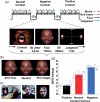The Kuleshov Effect: the influence of contextual framing on emotional attributions
- PMID: 17339967
- PMCID: PMC1810228
- DOI: 10.1093/scan/nsl014
The Kuleshov Effect: the influence of contextual framing on emotional attributions
Abstract
Filmmakers have long recognized the importance of editing techniques to guide the audiences' perceptions and enhance the impact of a scene. We demonstrate behaviorally that pairing identical faces with either neutral or emotionally salient contextual movies, an editing technique referred to as the 'Kuleshov Effect', results in both altered attributions of facial expression and mental-state. Using functional neuroimaging (fMRI), we show that faces paired with emotional movies enhance BOLD responses in the bilateral temporal pole, anterior cingulate cortices, amygdala and bilateral superior temporal sulcus relative to identical faces juxtaposed with neutral movies. An interaction was observed in the right amygdala when subtle happy and fear faces were juxtaposed with positive and negative movies, respectively. An interaction between happy faces and negative context was also observed in bilateral amygdala suggesting that the amygdala may act to prime or tag affective value to faces. A parametric modulation of BOLD signal by attribution ratings indicated a dissociation between ventrolateral and the ventromedial prefrontal cortex for negative and positive contextually evoked attributions, respectively. These prefrontal regions may act to guide appropriate choices across altering contexts. Together, these findings offer a neurobiological basis for contextual framing effects on social attributions.
Figures




Similar articles
-
Reexamining the Kuleshov effect: Behavioral and neural evidence from authentic film experiments.PLoS One. 2024 Aug 5;19(8):e0308295. doi: 10.1371/journal.pone.0308295. eCollection 2024. PLoS One. 2024. PMID: 39102395 Free PMC article.
-
Neural interaction of the amygdala with the prefrontal and temporal cortices in the processing of facial expressions as revealed by fMRI.J Cogn Neurosci. 2001 Nov 15;13(8):1035-47. doi: 10.1162/089892901753294338. J Cogn Neurosci. 2001. PMID: 11784442
-
Contextual memory bias in emotional events: Neurobiological correlates and depression risk.Psychoneuroendocrinology. 2025 Jan;171:107218. doi: 10.1016/j.psyneuen.2024.107218. Epub 2024 Oct 19. Psychoneuroendocrinology. 2025. PMID: 39531919
-
Neural circuitry of emotional face processing in autism spectrum disorders.J Psychiatry Neurosci. 2010 Mar;35(2):105-14. doi: 10.1503/jpn.090085. J Psychiatry Neurosci. 2010. PMID: 20184808 Free PMC article.
-
Distributed and interactive brain mechanisms during emotion face perception: evidence from functional neuroimaging.Neuropsychologia. 2007 Jan 7;45(1):174-94. doi: 10.1016/j.neuropsychologia.2006.06.003. Epub 2006 Jul 18. Neuropsychologia. 2007. PMID: 16854439 Review.
Cited by
-
Childhood Poverty Predicts Adult Amygdala and Frontal Activity and Connectivity in Response to Emotional Faces.Front Behav Neurosci. 2015 Jun 12;9:154. doi: 10.3389/fnbeh.2015.00154. eCollection 2015. Front Behav Neurosci. 2015. PMID: 26124712 Free PMC article.
-
The role of the basolateral amygdala in the perception of faces in natural contexts.Philos Trans R Soc Lond B Biol Sci. 2016 May 5;371(1693):20150376. doi: 10.1098/rstb.2015.0376. Philos Trans R Soc Lond B Biol Sci. 2016. PMID: 27069053 Free PMC article.
-
Influence of transient emotional episodes on affective and cognitive theory of mind.Soc Cogn Affect Neurosci. 2024 Mar 1;19(1):nsae016. doi: 10.1093/scan/nsae016. Soc Cogn Affect Neurosci. 2024. PMID: 38442706 Free PMC article.
-
How the Brain Converts Negative Evaluation into Performance Facilitation.Cereb Cortex. 2018 Feb 1;28(2):602-611. doi: 10.1093/cercor/bhw400. Cereb Cortex. 2018. PMID: 28057723 Free PMC article.
-
Transient emotional events and individual affective traits affect emotion recognition in a perceptual decision-making task.PLoS One. 2017 Feb 2;12(2):e0171375. doi: 10.1371/journal.pone.0171375. eCollection 2017. PLoS One. 2017. PMID: 28151976 Free PMC article.
References
-
- Adolphs R, Tranel D, Hamann S, et al. Recognition of facial emotion in nine individuals with bilateral amygdala damage. Neuropsychologia. 1999;37:1111–7. - PubMed
-
- Adolphs R, Tranel D, Buchanan TW. Amygdala damage impairs emotional memory for gist but not details of complex stimuli. Nature Neuroscience. 2005;8:512–8. - PubMed
-
- Anderson J, Bower GH. Recognition and retrieval processes in free recall. Psychological Review. 1972;79:97–123.
-
- Anderson AK, Phelps EA. Lesions of the human amygdala impair enhanced perception of emotionally salient events. Nature. 2001;411:305–309. - PubMed
-
- Anderson A, Christoff K, Stappen I, et al. Dissociated representations of intensity and valence in human olfaction. Nature Neuroscience. 2003;6:196–202. - PubMed
Publication types
MeSH terms
Grants and funding
LinkOut - more resources
Full Text Sources

